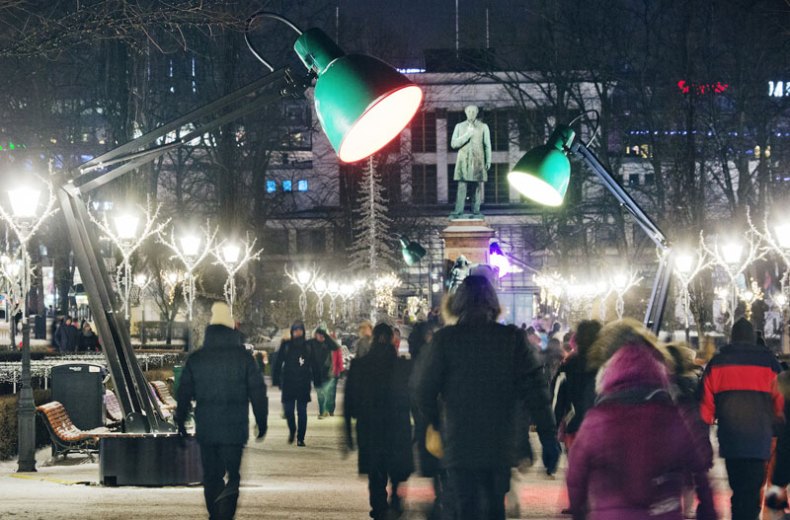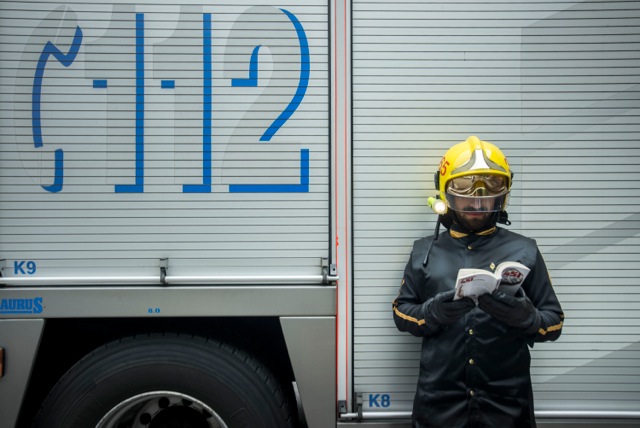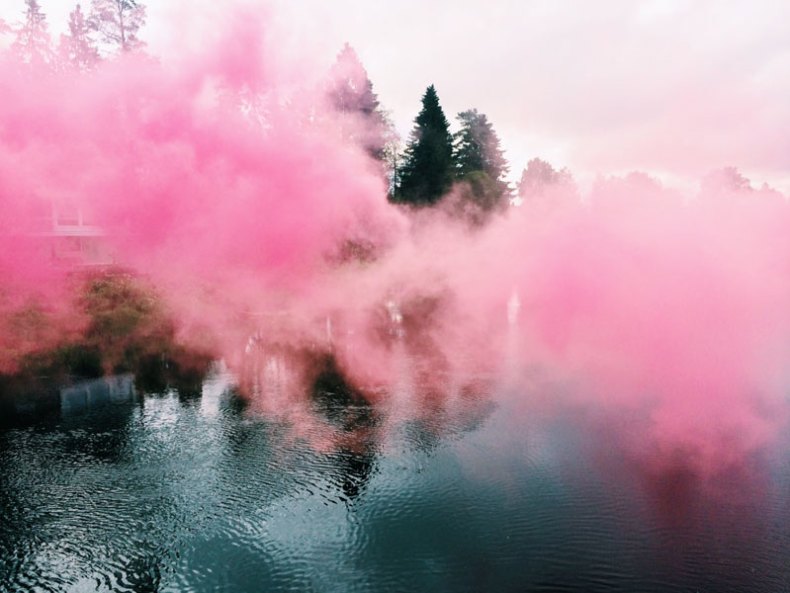After an unseasonably mild December, the Finnish winter has arrived in grand style. Snow is piled high in the streets, swathes of the Baltic Sea have frozen over, and temperatures in Helsinki have plunged as low as -27°C. With the sun glowing low over buildings and trees, it’s been exhilaratingly cold.
Long winters call for frequent entertainment, and this year’s Lux Helsinki – a five-day festival of art and light – was a popular success despite, or perhaps because of, the extreme cold. Some half a million people roamed the city centre on the trail of indoor and outdoor performances, projections, light-based installations, and street food.

Lampounette by TILT at the Esplanade Park. Part of Lux Helsinki. Photo: Lauri Rotko
Unfortunately, while Lux Helsinki goes from strength to strength (at least in terms of scale and audience figures) another arts initiative suddenly finds itself struggling for survival. Checkpoint Helsinki was founded in 2012 as a direct response to then nascent discussions about a possible Guggenheim Helsinki. The aim of Checkpoint was not simply to oppose the arrival of a Guggenheim but to grow out of a changed situation. As artist Terike Haapoja, chair of Checkpoint Helsinki, tells me, ‘A space opened in the political imagination. Suddenly politicians were considering large-scale investment in art.’
Checkpoint Helsinki was conceived as a way to establish the city’s art scene as a significant force within the international art world. Led by artists and other arts professionals, Checkpoint notably has no permanent space; instead, its board of directors and three full-time members of staff (plus one part-time) have functioned largely as a commissioning body with the aim of championing new forms of art. Checkpoint has produced 20 international art projects in the last three years, including conferences, publications, and performances. As well as commissioning such works, Checkpoint also intended to build a collection of works that could then tour the world. ‘We envision Helsinki as a birthplace of art not just an endpoint,’ says Haapoja, who represented Finland at the Venice Biennale in 2013.
But all this is now under threat. In December it was announced that the City of Helsinki was halting funding after just three years: the subsequent negotiations are ongoing. Checkpoint has already restructured in response to the news, with director Eva Neklyaeva moving over to the organisation’s board. Alternative sources of revenue are currently being sought.

Ahmet Öğüt’s ‘Fahrenheit 451: Reprinted’ was produced by Checkpoint Helsinki in 2013.
This has come as a huge surprise to many, not least those involved in Checkpoint Helsinki itself. ‘The whole organisation has been based around the idea of future contemporary art,’ says Haapoja. ‘It scans for possible futures for art and enables such projects to become reality. In five to 15 years we can see what will have become part of the art canon.’ Haapoja tells me that it was this long-term thinking that helped Checkpoint secure public funding in the first place. But now it seems that a lack of highly visible short-term successes may have proven damaging.
Checkpoint Helsinki’s projects have often been discursive or ephemeral in form, directly political in content. Key interests have been public space, economic inequality, war, violence, and the voices of the oppressed. Checkpoint has also launched a museum card club with the Finnish Museums Association, and a design competition for an alternative to the Guggenheim called The Next Helsinki.

Forza Rosa Fluff (2015), Klas Eriksson. A temporary sculpture at Isokyrö, produced by Checkpoint Helsinki.
Perhaps their work has simply been too overtly political. Or perhaps, such projects have been too niche for an organisation awarded some €800,000 from the City of Helsinki as well as other funds from Kone Foundation, Finnish Cultural Foundation, Swedish Cultural Foundation, and Finland’s Ministry of Culture. Haapoja admits that it took longer than planned to put together the structures by which the organisation could best function. But now there is a board, a team of associate members, and an advisory group. There are two powerful projects on the horizon: an archival intervention by South African art/editorial group Chimurenga at Kallio Library (the third part in a series curated by Ahmed Al-Nawas) and a major exhibition of work at Seurasaari open-air museum curated by Manifesta 10’s Joanna Warsza.
One of the issues that Checkpoint Helsinki has addressed head-on is the very purpose of public funding for the arts. Haapoja sees the organisation’s work as standing ‘in defence of the public good, the commons, and emerging, critical art as something owned by the people of the city’. She argues that what they’re doing is ‘exactly what public funding should be for’ because it is challenging and because such challenging work is unlikely to receive much in the way of sponsorship from the private sector. Nonetheless, Haapoja also acknowledges that, because what Checkpoint is doing is comparatively new, it is ‘not so easily understandable’ for politicians or for the public.
This is the classic double bind of public arts funding. It is precisely the radical work – that which does not lend itself easily to circulation within the market – that so depends upon public funding. But such funding is increasingly hard to justify in the face of economic austerity and public indifference. Who should decide what is in the public good? The public? This is one question Checkpoint Helsinki has sought to ask. Perhaps the discontinuation of its funding provides one answer.

Baltic Diary: Freezing weather and frozen art funding
CLOUD, by Caitlind r.c. Brown & Wayne Garrett at the crossing between Annankatu and Kalevankatu. Part of Lux Helsinki. Photo: Lauri Rotko
Share
After an unseasonably mild December, the Finnish winter has arrived in grand style. Snow is piled high in the streets, swathes of the Baltic Sea have frozen over, and temperatures in Helsinki have plunged as low as -27°C. With the sun glowing low over buildings and trees, it’s been exhilaratingly cold.
Long winters call for frequent entertainment, and this year’s Lux Helsinki – a five-day festival of art and light – was a popular success despite, or perhaps because of, the extreme cold. Some half a million people roamed the city centre on the trail of indoor and outdoor performances, projections, light-based installations, and street food.
Lampounette by TILT at the Esplanade Park. Part of Lux Helsinki. Photo: Lauri Rotko
Unfortunately, while Lux Helsinki goes from strength to strength (at least in terms of scale and audience figures) another arts initiative suddenly finds itself struggling for survival. Checkpoint Helsinki was founded in 2012 as a direct response to then nascent discussions about a possible Guggenheim Helsinki. The aim of Checkpoint was not simply to oppose the arrival of a Guggenheim but to grow out of a changed situation. As artist Terike Haapoja, chair of Checkpoint Helsinki, tells me, ‘A space opened in the political imagination. Suddenly politicians were considering large-scale investment in art.’
Checkpoint Helsinki was conceived as a way to establish the city’s art scene as a significant force within the international art world. Led by artists and other arts professionals, Checkpoint notably has no permanent space; instead, its board of directors and three full-time members of staff (plus one part-time) have functioned largely as a commissioning body with the aim of championing new forms of art. Checkpoint has produced 20 international art projects in the last three years, including conferences, publications, and performances. As well as commissioning such works, Checkpoint also intended to build a collection of works that could then tour the world. ‘We envision Helsinki as a birthplace of art not just an endpoint,’ says Haapoja, who represented Finland at the Venice Biennale in 2013.
But all this is now under threat. In December it was announced that the City of Helsinki was halting funding after just three years: the subsequent negotiations are ongoing. Checkpoint has already restructured in response to the news, with director Eva Neklyaeva moving over to the organisation’s board. Alternative sources of revenue are currently being sought.
Ahmet Öğüt’s ‘Fahrenheit 451: Reprinted’ was produced by Checkpoint Helsinki in 2013.
This has come as a huge surprise to many, not least those involved in Checkpoint Helsinki itself. ‘The whole organisation has been based around the idea of future contemporary art,’ says Haapoja. ‘It scans for possible futures for art and enables such projects to become reality. In five to 15 years we can see what will have become part of the art canon.’ Haapoja tells me that it was this long-term thinking that helped Checkpoint secure public funding in the first place. But now it seems that a lack of highly visible short-term successes may have proven damaging.
Checkpoint Helsinki’s projects have often been discursive or ephemeral in form, directly political in content. Key interests have been public space, economic inequality, war, violence, and the voices of the oppressed. Checkpoint has also launched a museum card club with the Finnish Museums Association, and a design competition for an alternative to the Guggenheim called The Next Helsinki.
Forza Rosa Fluff (2015), Klas Eriksson. A temporary sculpture at Isokyrö, produced by Checkpoint Helsinki.
Perhaps their work has simply been too overtly political. Or perhaps, such projects have been too niche for an organisation awarded some €800,000 from the City of Helsinki as well as other funds from Kone Foundation, Finnish Cultural Foundation, Swedish Cultural Foundation, and Finland’s Ministry of Culture. Haapoja admits that it took longer than planned to put together the structures by which the organisation could best function. But now there is a board, a team of associate members, and an advisory group. There are two powerful projects on the horizon: an archival intervention by South African art/editorial group Chimurenga at Kallio Library (the third part in a series curated by Ahmed Al-Nawas) and a major exhibition of work at Seurasaari open-air museum curated by Manifesta 10’s Joanna Warsza.
One of the issues that Checkpoint Helsinki has addressed head-on is the very purpose of public funding for the arts. Haapoja sees the organisation’s work as standing ‘in defence of the public good, the commons, and emerging, critical art as something owned by the people of the city’. She argues that what they’re doing is ‘exactly what public funding should be for’ because it is challenging and because such challenging work is unlikely to receive much in the way of sponsorship from the private sector. Nonetheless, Haapoja also acknowledges that, because what Checkpoint is doing is comparatively new, it is ‘not so easily understandable’ for politicians or for the public.
This is the classic double bind of public arts funding. It is precisely the radical work – that which does not lend itself easily to circulation within the market – that so depends upon public funding. But such funding is increasingly hard to justify in the face of economic austerity and public indifference. Who should decide what is in the public good? The public? This is one question Checkpoint Helsinki has sought to ask. Perhaps the discontinuation of its funding provides one answer.
More from this series
Unlimited access from just $16 every 3 months
Subscribe to get unlimited and exclusive access to the top art stories, interviews and exhibition reviews.
Share
Recommended for you
Baltic Diary: The Purpose of Art Prizes
The Lorck Schive art prize has an important role to play in Trondheim’s growing art community
Baltic Diary: The Art of Coffee
Art, made of coffee, shown in a bookshop: Ian Bourgeot’s work at Helsinki’s Arkadia breaks conventions in more ways than one
Baltic Diary: Rethinking the role of art in the city
Engagement, interaction, the co-creation of meaning: these are the museum buzzwords of today. But what do they actually mean?